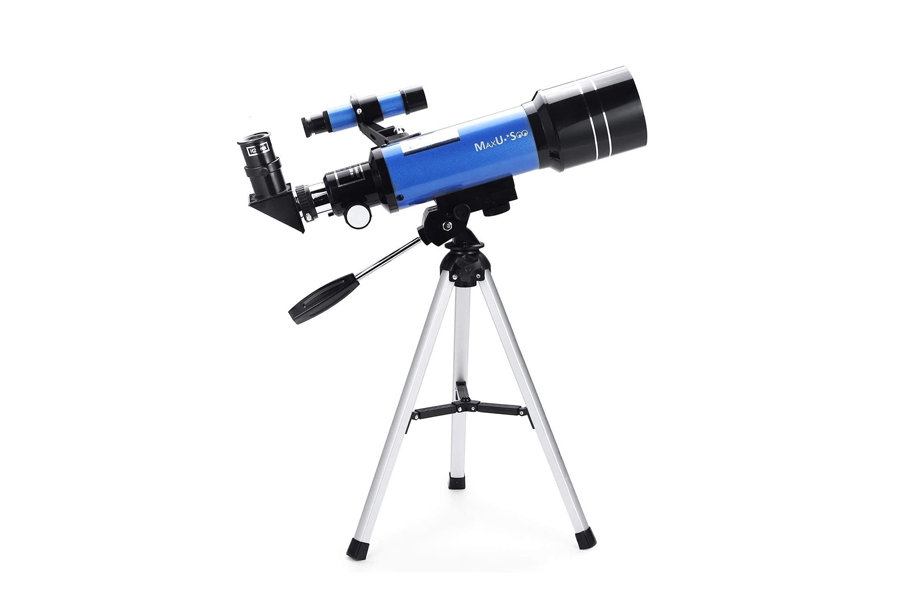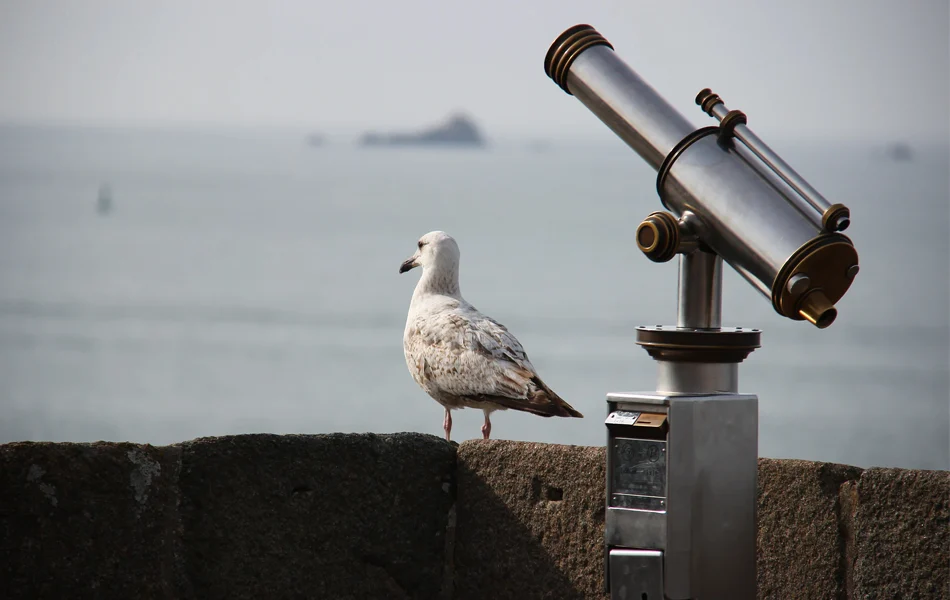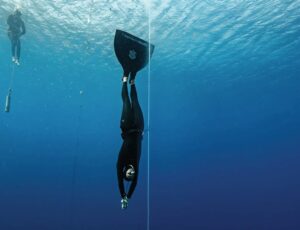I don’t think I know any humans who dislike a beautiful starry night, and if they exist, I don’t think I want to know them. Not all of us are cut out to be astronauts, so a good telescope is the closest most of us will get to exploring deep space. Read along for our guide to the best telescopes and how to use them to their maximum potential.
The best telescope
Gskyer Astronomical Refracting Telescope

Our best choice for telescopes is the Gyskyer telescope, with a 70mm aperture and its included accessories. This is an excellent, easy-to-use telescope for beginners. Set-up takes only a few moments. This telescope comes with a 70mm aperture, a 400mm focal length, two eyepieces, a Barlow lens, adjustable tripod, smartphone attachment, zenith mirror, finder scope, and carrying bag. The comprehensiveness of this kit means you have all the accessories you need to get started right away. The only things you may want to add are filters and a light pollution filter.
If you want to quickly share snaps of your nighttime views, this set is an excellent choice. Use the smartphone attachment and Bluetooth remote to snap photos. Based on reviews, the smartphone adapter is a bit small and may not work with larger smartphones.
Key features
- Refractor telescope
- Two eyepieces and Barlow lens included
- 70mm aperture
- 400mm focal length
- Smartphone attachment for photography
Pros
- Great starter telescope
- Accessories included
- Easy to set up and use
- Carry bag for transport
- Hands-free photos
Cons
- Smartphone adapter is a bit small
- Not high-enough quality for DSLR images
- No filters included
See Gskyer Astronomical Refracting Telescope on Amazon
See Gskyer Astronomical Refracting Telescope on Walmart
Celestron 70mm Travel Scope Telescope

If you’re always on the go and want a telescope that can keep up with all of your adventures, the Celestron 70mm Travel Scope is an excellent choice. With this telescope, you get a 70mm aperture, fully-coated glass optics, 400mm focal length, two eyepieces, and a carry case. The carrying case for this scope comes in backpack form, meaning you’ll have your hands free to carry anything else you’ll need. This is one of the best amateur telescopes because it strikes the balance of portability, quality, and cost exceptionally well.
At just over three pounds, this telescope easily goes wherever you do. One of our favorite features is that it includes the Starry Night educational software that allows you to learn about the night sky and helps you locate objects in real-time.
Key features
- Fully-coated optics
- 400mm focal length
- 70mm aperture
- Included Starry Night software
Pros
- Quick set-up
- Included software
- Portable
Cons
- Minimal accessories
- Limited magnification with included eyepieces

The MaxUSee 70mm telescope is one of the best budget telescopes on our list. While it doesn’t top the list in features, it does provide an excellent, budget-friendly option for beginner astronomers. The 70mm aperture and 400mm focal length is relatively standard and matches other devices on our list. This table-top, refractor telescope comes with four eyepieces, a Barlow lens, tabletop tripod, smartphone adapter, and other accessories.
This gadget is an excellent starting point to get kids excited about astronomy and science if you have children. Your kids will love using this device to explore, and night sky viewing could turn into an activity for the whole family to enjoy together. The included smartphone adapter allows you to capture images of all of your finds.
Key features
- Refractor telescope
- 70mm aperture
- 400mm focal length
- Four eyepieces and Barlow lens included
Pros
- Lightweight
- Plenty of accessories
- Included smartphone adapter

The Celestron NexStar 8SE Telescope is a combination of bold, capable, and beautiful. A burnt orange exterior tube stands out from the other models on our list, and the technology behind this device makes it truly impressive. A fully-automated mount makes finding and automatically tracking stars, planets, and celestial bodies easy.
This telescope provides connectivity to your DSLR camera.
Key features
- Computerized mount
- Tracking capabilities
- Free Starry Night software
Pros
- Excellent optics
- Computerized tracking
- Portable
- Lightweight for a computerized telescope
Cons
- Plastic accessories
- Limited accessories
- No carrying case included

Celestron has a solid reputation based on its construction of quality telescopes for the last 50 years. The PowerSeeker 127EQ Telescope is one of the best budget telescopes available. While there are cheaper telescopes on our list, it provides exceptional quality at the price point.
The PowerSeeker 127EQ boasts a 127mm aperture and 1000mm focal length, towering over its direct competitors. Two included eyepieces and a Barlow lens allow for maximum magnification and minimal need to order extra accessories. The only additional parts you may need are filters.
This telescope also includes free access to the Starry Night software with information about 10,000 celestial bodies and an accessory tray to keep everything organized. At 28 pounds, this telescope isn’t the most portable option on our list, but if you’re willing to move it, it won’t be a back-breaking endeavor.
Key features
- Reflector telescope
- 127mm aperture
- 1000mm focal length
- Two eyepieces and Barlow lens
- German equatorial mount
Pros
- Included accessories
- Powerful
- Included software
Cons
- No carrying case
- Finder scope is poor
See Celestron PowerSeeker 127EQ Telescope on Amazon
See Celestron PowerSeeker 127EQ Telescope on Walmart

Another excellent telescope for beginners. This telescope boasts a 70mm aperture and a 360mm focal length. There are no tools required for set up and it is easy to use, making it an excellent gift for kids.
In the box, you’ll receive two eyepieces, a finder scope, and an adjustable tripod. You may want to consider picking up a Barlow lens or additional filters.
Key features
- Refractor telescope
- 70mm aperture
- 260mm focal length
Pros
- Great for kids
- Budget-friendly
- Easy to assemble
Cons
- Sliding parts can make the telescope wobbly
- Sensitive to vibrations and movement
- No carrying case

The Celestron NexStar 130SLT is a powerful, compact telescope. This telescope uses the Starry Night software, like several of the telescopes on our list, to find and track celestial objects. If finding objects manually isn’t for you, you might want to opt for a computerized telescope; it will make your sky viewing much more straightforward.
This reflector telescope has a 130mm aperture and a 650mm focal length. In the box, you’ll also find two included eyepieces and a finder scope. You may want to pick up some filters and a Barlow lens to complete your kit if this telescope ends up being your choice. Lastly, this product only weighs just over 11 pounds, very light for such a powerful telescope.
Key features
- Computerized
- 130mm aperture
- Reflector telescope
- 650mm focal length
Pros
- Includes full-height tripod and two eyepieces
- Lightweight
- Wide-field views
Cons
- Sensitive to vibration
- Short battery life
See Celestron NexStar 130SLT Computerized Telescope on Amazon
See Celestron NexStar 130SLT Computerized Telescope on Walmart

Our next telescope is one of the higher-end models available for beginner and amateur astronomers: the Sky Watcher Classic 150. It is a Dobsonian telescope with an impressive 153mm aperture and six-inch focal length. This powerhouse weighs about 40 pounds between the base and the scope, making it less portable, but with a little bit of elbow grease, you can still get it moved. You will also receive two eyepieces, a rack and pinion style focuser, an adapter, and a finder scope. Just add in a Barlow lens and light pollution filter, and then you’ll have everything you need for exploring the night sky.
Fully multi-coated borosilicate primary and secondary mirrors provide exceptional viewing, and Teflon bearings ensure smooth movement. A unique feature is the tension control handles, which allow for accurate movement even if your balance is a little off.
Key features
- Fully multi-coated lenses
- 6-inch focal length
- 153mm aperture
- Dobsonian telescope
Pros
- Sturdy
- Portable
- Precise focusing
- Smooth movement
Cons
- Heavy
- Rack and pinion focuser may be challenging to use as a beginner
See SkyWatcher Classic 150 S11600 Traditional Dobsonian on Amazon

The Mak60 telescope is an excellent, affordable, and kid-friendly telescope. This telescope is one of the few Maksutov-Cassegrain telescopes on our list. A Maksutov-Cassegrain telescope is a compound telescope that uses a mirror and a lens to capture light and present an image.
An impressive 750mm focal length in just an eight-inch tube keeps this product light but robust. Weighing in at just under three pounds, this telescope is incredibly easy to carry and store. You’ll receive just a singular eyepiece with this product, so you may want to invest in an additional eyepiece, a Barlow lens, and filters. This telescope comes with a tabletop tripod, not a full-height tripod, so make sure you have something to set this scope on.
Key features
- 750mm focal length
- Fully multi-coated glass optical lens
- Compound telescope
Pros
- Lightweight
- Easy to use
- Kid-friendly
- Budget-friendly

Innovative technology and incredible power blend harmoniously in the Sky-Watcher Flextube 250 telescope. It has a collapsible design, which allows for easy storage and portability. Teflon bearings make for smooth movement, and the 10:1 Crawford-style focuser makes for precise focusing.
This telescope is a Dobsonian telescope, a reflector telescope with an altazimuth mount that allows for rotation on two axes. This technology has allowed home telescopes to become larger and more powerful. You’ll also receive two eyepieces and a Crawford-Style focuser. But it is pricey, so be prepared to pay a premium.
Key features
- Dobsonian telescope
- Ten-inch aperture
- Sleek design
Pros
- Collapsible
- Portable
- Powerful

The Sky Watcher Virtuoso is a compound Maksutov-Cassegrain telescope with a 90mm aperture. This tabletop telescope also includes a bracket for astral photography that supports a smartphone, camcorder, or DSLR. Canon Rebel DSLR users get the added benefit of shutter release functionality. The build of this telescope will make it difficult to use with a tripod, so you are limited to tabletop usage with this option.
At just 17 pounds, this isn’t the lightest telescope on our list, but it is still portable, compact, and easy to store anywhere because of its tabletop design. This product is one of the only telescopes on our list that comes with sun filters, a bonus!
Key features
- Fully multi-coated lenses
- Bracket for DSLR
- Camcorder and smartphone
- Altazimuth mount
Pros
- Lightweight
- Included solar filter

The final telescope on our list is a powerful model with an impressive aperture of 127mm. This product is a blend of lenses and mirrors in the classic Maksutov-Cassegrain compound style.
In the box, you’ll find the telescope, two eyepieces, and a finder scope. You won’t find any base, though. This telescope comes with a dovetail mount that allows it to mount onto almost any tripod or base. You will need to purchase your base separately, though. Be sure you get something sturdy and stable to minimize vibrations affecting your viewing.
Key features
- Compound-style reflector telescope
- 127mm focal length
Pros
- Lightweight
- Portable
- Great for planetary viewing
Telescope buying guide
Types of telescope
- Refractor Telescope – A refractor telescope uses a lens to capture and present us the image. Generally, refractor telescopes allow for more light to be gathered by the lens and present a clearer picture.
- Reflector Telescope – Reflector telescopes use a system of mirrors to reflect light and build the image. These are cheap and easy to assemble and are the most popular kind of telescopes. These are sometimes called Newton telescopes.
- Compound Telescope – A compound telescope combines the technology in both reflector and refractor telescopes, creating a system of lens and mirrors to craft the image.
Benefits of owning a telescope
- Educational – Telescopes can be used as an educational tool. As you find new items, you can research what you see and build a map of the night sky.
- Daytime Use – Most modern telescopes are capable of being used during the daytime as well as at night.
- Discover New Things – Believe it or not, most astronomical discoveries are made by amateurs! If you find something you can’t identify, you may have discovered a new celestial body! There’s a vast amount of space, particles, and planets out there; you may just find something that scientists have missed.
How to get the most out of your telescope
- Learn how to use it – Reading the instructions, watching YouTube videos, and checking out online reviews are all excellent ways to learn about your new tool.
- Learn conditions – If you live in a city or densely-populated area, you probably struggle with light pollution blocking your view of the night sky. Cloudy evenings and nights are also poor conditions for viewing the night sky. Look for clear nights and avoid big cities, you may need to head out into nature to get a clearer view.
- Practice – Take the time to practice scanning the night sky and identifying objects. The more time you spend with your eye glued to the scope, the more comfortable you’ll be. Like anything, you’ll need to practice to get good at using your telescope.
- Research – As you find things in the sky, take the time to research the items you found. If your telescope is a manual one or without a booklet, a quick internet search should help you identify what you are looking at.

Telescope FAQ
Q: What is a telescope?
A telescope is an optical instrument that uses a system of lenses, mirrors, or both to observe distant objects, usually in the night sky. Still, You can use this tool during the day and for other purposes. Telescopes come in varying strengths and capabilities from amateur and beginner telescopes up to technological behemoths like the Hubble telescope.
Q: Do telescope accessories make a difference?
Certain telescope accessories aren’t worth the money, but others are valuable tools that can enhance your viewing experience and capabilities. A Barlow lens fits between the focuser and the eyepiece and increases the magnification, making it a helpful tool. Remember that you don’t always need additional magnification for certain objects, it may leave you with a bright but fuzzy object. Lastly, filters and LPR filters are helpful tools to increase your ability to see distant objects. Filters enhance color and visibility, giving you crisper pictures. LPR filters or light pollution filters are among the most powerful tools if you live anywhere near light pollution. If you add accessories to your kit, a light pollution filter should be one of the first items you purchase.
Q: What can I see with my telescope?
What you can see with your telescope depends on the quality and focal length. Generally, the moon and larger planets are a great starting place. After that, you can look for star clusters, constellations, and galaxies. You’ll want to keep an eye on astronomy outlets, so you know when major celestial events are happening.
Q: How do I find objects in the sky?
Locating objects in the night sky is often done using a set of angular coordinates. Before we explain the system, you need a few words defined. A zenith is the point directly overhead in the celestial sphere, and the celestial sphere is a circle consisting of all points 90 degrees from the zenith. From there, you’ll now need the altitude of an object, which is the angular distance above the celestial horizon and the azimuth coordinates. The azimuth is the angular distance (measured eastward from the north along the celestial horizon until you reach a point closest to the object. With practice, this will feel more familiar, and you’ll develop your own reference points in your location.

Q: How do I correctly focus my telescope?
Generally, focusing a telescope is done via knobs that change the distance between the lens and the eyepiece. Adjust the knobs until the object in question comes into sharp focus.
Q: Image orientation: is it upside down?
There is not necessarily an up or down in space, so in theory, the images you are seeing are not upside down. However, because telescopes use mirrors, lenses, or a blend of both, images will appear technically upside down or backward if a diagonal is correcting the image.
Q: I want to take photographs with my telescope; what do I need?
If you’re hoping to take photos of the night sky with your DSLR, you will need special attachments for your particular camera. Additionally, not all telescopes are suitable for photographing the night sky. You will need a high-quality scope to craft images. If you are just looking for smartphone images, you can start withholding your phone’s camera lens to the eyepiece. Alternatively, there are adapters and tools you can buy to attach your phone to the eyepiece, allowing for more stable images and hands-free controls. Before you attempt to capture an image with any device, make sure the object you’re trying to photograph is centered and focused in the eyepiece.
Q: How do I store my telescope?
If you want your telescope to last, proper storage is a must. Be sure never to leave your telescope outdoors as the moisture in the air can cause mildew, mold, or even rust. You should plan to store your telescope in a dry place with a consistent room temperature. Be sure to secure all dust caps and place your telescope in a storage bag or box. Additionally, allowing your telescope to acclimatize to an environment before storage can make a difference. Acclimating your telescope means allowing it to sit for about an hour in the new environment you plan to store it.
Sources:
- How Do You Store Your Telescope? – See The Night Sky
- How to Snap Awesome Photos of Night-Sky Objects with Your Smartphone – Space
- Observing the Night Sky: Locating Objects – Employees Oneonta
- Telescope Accessories: What Do You Really Need? – Magazine Science Connected
- Reflector vs. Refractor Telescopes – Vaonis






